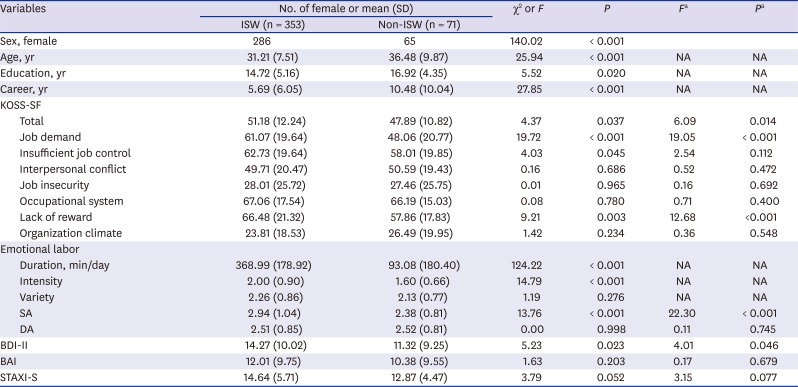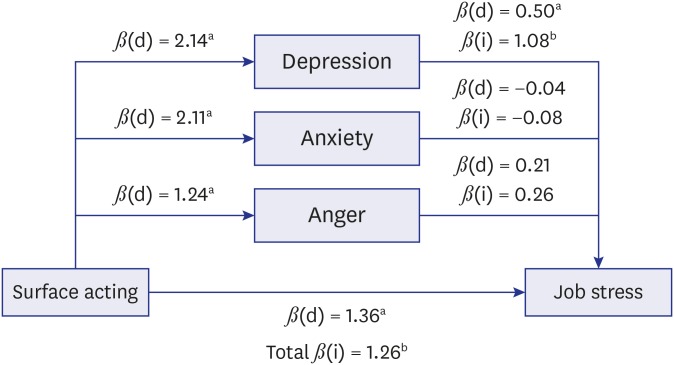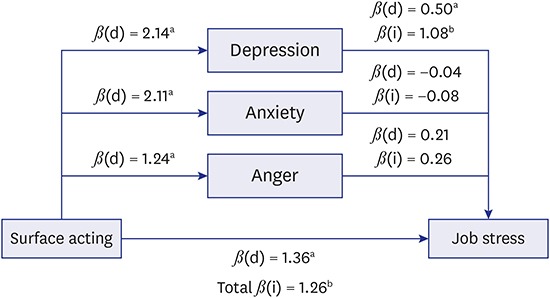1. Zapf D. Emotion work and psychological well-being: a review of the literature and some conceptual considerations. Hum Resour Manage Rev. 2002; 12(2):237–268.
2. Grandey AA. Emotion regulation in the workplace: a new way to conceptualize emotional labor. J Occup Health Psychol. 2000; 5(1):95–110. PMID:
10658889.
3. Hochschild AR. The Managed Heart: Commercialization of Human Feeling/Arlie Russell Hochschild. Berkeley: University of California Press;1983.
4. Brotheridge CM, Lee RT. Development and validation of the emotional labour scale. J Occup Organ Psychol. 2003; 76(3):365–380.
5. Morris JA, Feldman DC. The dimensions, antecedents, and consequences of emotional labor. Acad Manage Rev. 1996; 21(4):986–1010.
7. Cho JJ, Kim JY, Chang SJ, Fiedler N, Koh SB, Crabtree BF, et al. Occupational stress and depression in Korean employees. Int Arch Occup Environ Health. 2008; 82(1):47–57. PMID:
18301911.
8. Melchior M, Caspi A, Milne BJ, Danese A, Poulton R, Moffitt TE. Work stress precipitates depression and anxiety in young, working women and men. Psychol Med. 2007; 37(8):1119–1129. PMID:
17407618.
9. Wang J. Work stress as a risk factor for major depressive episode(s). Psychol Med. 2005; 35(6):865–871. PMID:
15997606.
10. Brotheridge CM, Grandey AA. Emotional labor and burnout: comparing two perspectives of “people work”. J Vocat Behav. 2002; 60(1):17–39.
11. Feskanich D, Hastrup JL, Marshall JR, Colditz GA, Stampfer MJ, Willett WC, et al. Stress and suicide in the nurses' health study. J Epidemiol Community Health. 2002; 56(2):95–98. PMID:
11812806.
12. Kovacs M, Kovacs E, Hegedu K. Emotion work and burnout: cross-sectional study of nurses and physicians in Hungary. Croat Med J. 2010; 51(5):432–442. PMID:
20960593.
13. Yoon SL, Kim JH. Job-related stress, emotional labor, and depressive symptoms among Korean nurses. J Nurs Scholarsh. 2013; 45(2):169–176. PMID:
23470274.
14. Chang SJ, Koh SB, Kang D, Kim SA, Kang MG, Lee CG, et al. Developing an occupational stress scale for Korean employees. Korean J Occup Environ Med. 2005; 17(4):297–317.
15. Beck AT, Steer RA, Ball R, Ranieri W. Comparison of Beck depression inventories -IA and -II in psychiatric outpatients. J Pers Assess. 1996; 67(3):588–597. PMID:
8991972.
16. Beck AT, Epstein N, Brown G, Steer RA. An inventory for measuring clinical anxiety: psychometric properties. J Consult Clin Psychol. 1988; 56(6):893–897. PMID:
3204199.
17. Spielberger CD. Manual for the State-Trait Anger Expression Inventory (STAXI). Odessa, FL: Psychological Assessment Resources;1988.
18. Beck AT, Steer RA, Brown GK. Manual for the Beck Depression Inventory-II. 2nd ed. San Antonio, TX: The Psychological Corporation;1996.
19. Forgays DG, Forgays DK, Spielberger CD. Factor structure of the state-trait anger expression inventory. J Pers Assess. 1997; 69(3):497–507. PMID:
9501480.
20. Hayes AF. Introduction to Mediation, Moderation, and Conditional Process Analysis: a Regression-Based Approach. New York, NY: Guilford Press;2013.
21. Tennant C. Work-related stress and depressive disorders. J Psychosom Res. 2001; 51(5):697–704. PMID:
11728512.
22. Park SG, Min KB, Chang SJ, Kim HC, Min JY. Job stress and depressive symptoms among Korean employees: the effects of culture on work. Int Arch Occup Environ Health. 2009; 82(3):397–405. PMID:
18622624.
23. King LA, Emmons RA. Conflict over emotional expression: psychological and physical correlates. J Pers Soc Psychol. 1990; 58(5):864–877. PMID:
2348373.
24. Smith TW. Hostility and health: current status of a psychosomatic hypothesis. Health Psychol. 1992; 11(3):139–150. PMID:
1618168.
25. Abraham R. Emotional dissonance in organizations: antecedents, consequences, and moderators. Genet Soc Gen Psychol Monogr. 1998; 124(2):229–246. PMID:
9597747.
26. Morris JA, Feldman DC. Managing emotions in the workplace. J Manag Issues. 1997; 9(3):257–274.








 PDF
PDF Citation
Citation Print
Print




 XML Download
XML Download